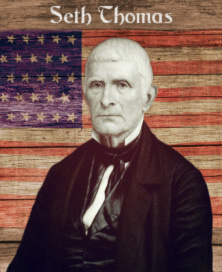 Seth Thomas - a huge name in American Clocks and to this day multitudes of clocks can be found branded Seth Thomas. There are numerous questions asked online about the Seth Thomas Clock Company and their clocks:
Seth Thomas - a huge name in American Clocks and to this day multitudes of clocks can be found branded Seth Thomas. There are numerous questions asked online about the Seth Thomas Clock Company and their clocks:1) Are Seth Thomas Clocks still made?
2) Where is the Seth Thomas Clock Company?
3) How do I date my Seth Thomas Clock?
Just to name a few.
I may be able to help answer some of these questions here.
But more than this, the hope is to try to enhance the online history of Seth Thomas. It amazes me how history becomes obscure and even lost, gradually falling into misunderstandings and half-truths. Even what could be considered modern history (from 1950 to current day) becomes obscure, especially online, as people start copying and pasting errors and taking these errors as facts.
NOTE: Throughout this discussion, references to images of actual newspaper articles will be provided as supporting information.
Here are of the common threads of thought that are erroneous, but taken as fact by many clock collectors:
- General Times bought the Seth Thomas Clock Company in 1930.
- Talley Industries bought Seth Thomas in 1968.
- The Seth Thomas Clock Company continues under different ownership to this day.
When I've brought up these errors in the past, some have said, "oh, you know what is meant," or "it's no big deal."
However, to some, the truth is a big deal.
For example: Did you know:
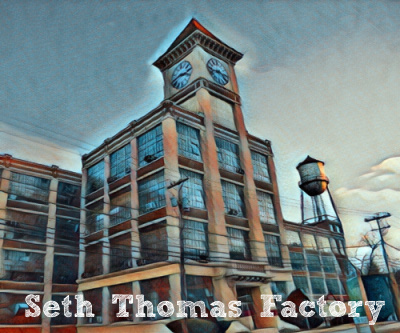
- The Seth Thomas Clock Company was never bought by General Time Corporation.
- A catastrophic flood in the northeastern United Stated in 1955 essentially ended production of clock mechanisms by the company.
- The Seth Thomas Clock Company experienced a hostile take over.
- The Seth Thomas Clock Company was forced out of it's New England home town of Thomaston (named after Seth Thomas) and sent south - leaving most of it's loyal workers and upsetting the local community.
- The hostility, anger and sadness was so great in Thomaston that a mock funeral for The Seth Thomas Company was held in the early 1980s - which foreshadowed the company's eventual doom.
- The Seth Thomas Clock Company was eventually "bought back" from Talley Industries by stockholders in 1988, but ultimately went bankrupt and ceased to exist as a company in 2001.
- Modern Clocks labeled Seth Thomas have nothing to do with the Seth Thomas Clock Company.
And finally, I bet you never knew that a new, Seth Thomas Mantel clock was burned in public during that mock funeral I mentioned. I don't know why, but this really stuck with me - to the point that I bought that model clock.[1]
You may think I'm being dramatic, but the title of this article could have been
The Seth Thomas Clock Company - Great American Success Story or Great American Tragedy. You Decide.
History
The history of the Seth Thomas Clock Company - which can be traced back to 1813 encompasses too much information for this article. But I'd like to hit some highlights to help you appreciate the magnitude of this company's influence in the United States.
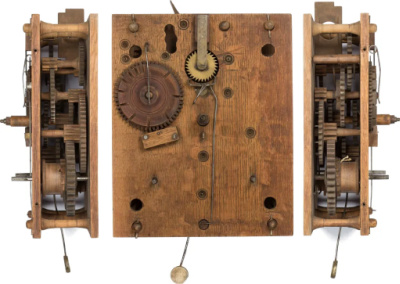 In the early 1800s American clock making was revolutionized by Eli Terry and his associates Seth Thomas and Silas Hoadley when they pioneered mass production manufacturing of clocks for homes - first tall case clocks and later, the very popular shelf or mantel clocks.
In the early 1800s American clock making was revolutionized by Eli Terry and his associates Seth Thomas and Silas Hoadley when they pioneered mass production manufacturing of clocks for homes - first tall case clocks and later, the very popular shelf or mantel clocks.While the French and Germans had long been using brass for their clock mechanisms, the Americans sought to produce a clock that the average American could afford. That's why the first Seth Thomas clocks had wooden clock works. These clocks, undoubtedly would have been laughed at by the Europeans, who at the time, were producing clocks that were beautiful, ornate masterpieces of clock-making craftsmanship. Yet, those clocks were essentially reserved for the wealthy and royalty. This is where the new American Clock Makers left their mark - they brought time keeping to rural and small town America, helping to set the stage for the Industrial Revolution in the United States. These early wooden clocks often made their way across America on horse drawn wagons of the Yankee peddlers - the door to door salesman of the day.
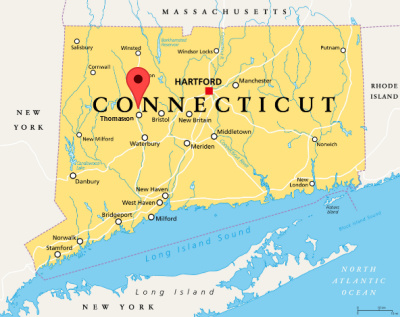 Seth Thomas set up his clock making enterprise in Plymouth, Connecticut in a section of town known as Plymouth Hollow. In 1853 the Seth Thomas Clock Company was formally incorporated. Thomas died 6 years later, on January 29, 1859, in Plymouth Hollow, the company passing to the control of his sons. Near the end of the Civil War, Plymouth Hollow, Connecticut started being referred to as "Thomaston" in honor of the Thomas family. But it wasn't until July 6, 1875 that the Plymouth Hollow district formally separated from Plymouth and incorporated as Thomaston to commemorate Seth Thomas - a name the town with a current population of around 8,000 bears to this day.
Seth Thomas set up his clock making enterprise in Plymouth, Connecticut in a section of town known as Plymouth Hollow. In 1853 the Seth Thomas Clock Company was formally incorporated. Thomas died 6 years later, on January 29, 1859, in Plymouth Hollow, the company passing to the control of his sons. Near the end of the Civil War, Plymouth Hollow, Connecticut started being referred to as "Thomaston" in honor of the Thomas family. But it wasn't until July 6, 1875 that the Plymouth Hollow district formally separated from Plymouth and incorporated as Thomaston to commemorate Seth Thomas - a name the town with a current population of around 8,000 bears to this day.The numbers and types of clocks exploded while the company was under control of The Thomas brothers. The expansion included: Regulator clocks (1860), spring driven clocks (1855—1860), Perpetual calendar clocks (1863—1917), walnut kitchen clocks (1884—1909), Adamantine finish mantel clocks (1885—1917), black enameled iron cased clocks (1892 - 1895), oak kitchen clocks (1890 - 1915), tambour clocks (1904), chime clocks, (1909), and electric A/C clocks (1928).
Stepping back in time, around 1865, the Seth Thomas Clock Company bought into the production of tower clocks and street clocks. The tower clocks consist of huge mechanisms that even now, probably run a tower clock near you. There were probably 3000 tower clocks built and installed by Seth Thomas in nearly every state and in multiple foreign countries. The most famous of the big clocks include Philadelphia Hall and Grand Central Station. The production of tower clocks by Seth Thomas continued until 1929 but enough parts remained so that the last Seth Thomas Tower clock installation occurred in 1942.
All this I'm sharing to give you a grasp of how huge the Seth Thomas name and reputation had become. The company even made pocket watches from 1885 to 1914.
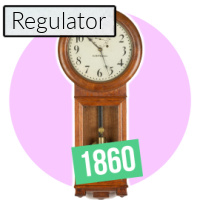



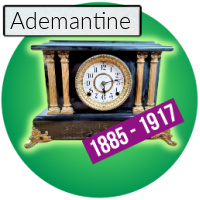


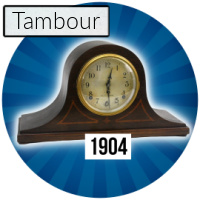
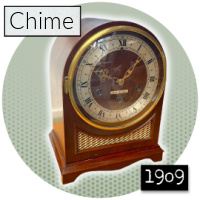

Merger of two Clock Giants
At the beginning of the Great Depression, the stockholders of Seth Thomas Clock Company and the Western Clock Company of Illinois (clock makers under the trade name Westclox) approved a merger on November 12, 1930. The companies were combined through the formation of a holding company, General Time Instruments Corporation. This marked the formal passing of the company from control of the Thomas family. Going forward, Seth Thomas would be known as the Seth Thomas Division of General Time Corporation. One of the historical inaccuracies often repeated is that "General Time Corporation bought Seth Thomas Clock Company in 1930." [2]
Seth Thomas ends manufacture of clock movements.
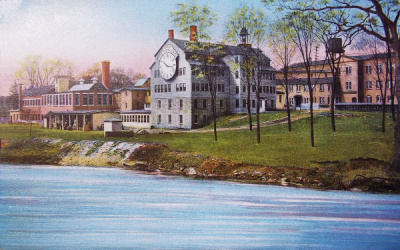 The Great Flood of 1955, greatly damaged the Seth Thomas factory in Thomaston, Connecticut.
The Great Flood of 1955, greatly damaged the Seth Thomas factory in Thomaston, Connecticut.In August 1955 two major hurricanes passed the north eastern US coast producing record setting flooding over much of the region. Hurricane Connie on August 11-12 resulted 4-6 inches of rainfall over southern New England. This resulted in saturation conditions just before hurricane Diane moved through August 18-19 resulting in rainfall up to 20 inches over a two day period. Over 200 dams in New England suffered partial to total failure. The state of Connecticut suffered the most in the region. There were 77 lives lost in Connecticut (of the 180 lives total that were lost). And more than half of the 680 million dollars damage from the 1955 floods (350 million dollars) occurred in Connecticut.
Following this catastrophe, Seth Thomas did not resume clock movement manufacturing at their former level and eventually ceased production altogether. Going forward the company began importing clock movements, mostly from Germany. The Hermle Company made many clock movements for Seth Thomas clocks. The clock I discussed at the beginning, which was burned, has a Hermle clock movement with chime.
In the years that followed, Seth Thomas became a large distributor of clocks of all sorts, while still producing their iconic wood mantel clocks and grandfather clocks with German movements. You can see the variety and change of styles as the catalogs progress from the 1930s, 40s, 50s, 60s and 70s. They kept pace the the times. Many of the modern clocks were made in Germany and some in Japan, including the flip clocks and digital desk clocks. By 1970 there would be untold millions of clocks bearing the Seth Thomas name.
Selected Catalog Pages
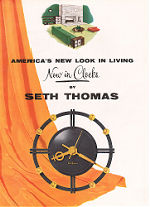
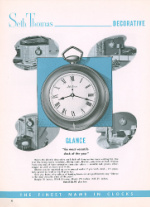
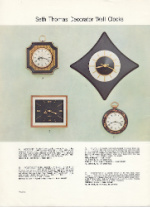

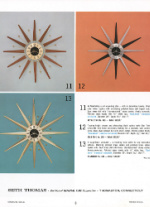


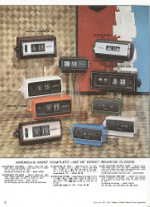
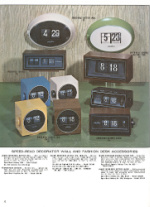
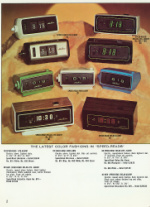
[catalog pages made possible by Clock History]
Enter Talley Industries
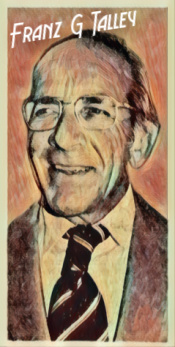 In the late 1960s some in the business world considered Talley Industries obscure. [3] The company, presided over by German born Franz Talley, was known primarily for making pilot ejection seats for the US military - although later they made large profits from air bag technology. In 1967, Tally Industries reported a net income of 3.6 million dollars on sales of over just over 24 million (10.6% return), while General Times had a net of 3.88 million on sales of 129.5 million (2.9 % return). [4]
In the late 1960s some in the business world considered Talley Industries obscure. [3] The company, presided over by German born Franz Talley, was known primarily for making pilot ejection seats for the US military - although later they made large profits from air bag technology. In 1967, Tally Industries reported a net income of 3.6 million dollars on sales of over just over 24 million (10.6% return), while General Times had a net of 3.88 million on sales of 129.5 million (2.9 % return). [4]In 1968 Franz Talley signaled his desire for a merger of General Time with Talley Industries. [5] It became very clear, very quickly, that the board of directors of General Time were strongly against this merger. Talley then proceeded with a hostile takeover of the company. The rancor of the moment can be seen in a large newspaper advertisement put out by the board of General Times encouraging stockholders to not vote in Franz Talley and his team to the board of directors, warning that they did not have the company's interest in mind. [6] In a protracted proxy battle, Talley secured enough shareholder votes to get himself and his hand-picked crew elected. They then immediately worked to get the merger completed.[7] The merger was finally approved by the SEC in January 1970. [8]
You'll often read that "Talley Industries bought General Time in 1968." As you know now, that's not at all how the transaction transpired. In such mergers there is often payouts and stock exchanges that get distributed among the shareholders - but they did not buy General Time - It was acquired in a hostile takeover which was not complete until 1970. So you know if you see a label with "Talley Industries" on a Seth Thomas clock - it had to be made between 1970-1988 (we'll discuss the significance of 1988 later).
The bitterness from the takeover was not over in 1970 and the SEC even jumped into the ring.
The SEC had filed a lawsuit against Talley Industries in 1968 alleging that they had obtained their controlling shares of General Time Corporation illegally. [9] That suit eventually failed and the appeal was thrown out by a federal judge allowing the merger to proceed. However, in 1974 Talley Industries settled a 75 million dollar lawsuit by shareholders (which included SEC input) arising from the takeover of General Time and dealing with too low of a price being paid for shares of General Time.[10]
With the General Time acquisition and other mergers, Talley vaulted from a relatively small defense products supplier to a diversified, multinational conglomerate with annual sales of nearly $300 million a year by the mid-1970s - allowing Franz Talley to achieve his goal of becoming a Fortune 500 company.
Tough Times ahead (a timeline)
June 18, 1978, founder and namesake of Talley Industries, Franz G Talley died of a heart attack at the age of 59 in Los Angeles, Ca.[11]
General Times Headquarters was moved from Stamford, Connecticut to Norcross, Georgia in 1979.
November 1982 - In a move that shocked the town named after Seth Thomas, Talley Industries directed that operations at the Seth Thomas factory in Thomaston, Connecticut move to Athens, Georgia and merge with the Westclox factory there (Westclox as we know, being the other clock-making division of General Time).[12] The union that represented the Seth Thomas workers, Local 1082 of the United Auto Workers, mounted a failed attempt to stop the move by filing an unfair labor practice charge with the National Labor Relations Board claiming that the Union should have been consulted before the plant was closed.[13]
Sunday, April 10, 1983 2pm - a mock funeral for the Seth Thomas company took place in Thomaston. This involved a mantel clock that I have recently acquired - and is not commonly found for sale online. I will expand more on this little known bit of history of the company later.[1]
April 15, 1983 - Seth Thomas Clockworks Factory in Thomaston formally closed after the last 4 workers were laid off. [1]
In the late 1980s Talley Industries had to undergo major restructuring to return to profitability. In October 1987, Talley Industries announced that it would divest itself of most of General Time's assets. [14]
General Time Buy Back
 1988 Fred Pistilli and four colleagues implemented a management buyout from Talley Industries. [15] This positioned Pistilli as president, CEO, and principal owner of General Time. The fact that the control of Seth Thomas was bought out from Talley Industries is a little known or reported fact about Seth Thomas and General Time. The Talley Industries name on labels was no longer present on Seth Thomas clocks after 1988. This can confuse some collectors as they may assume the lack of the Talley name means the clock is a pre-1970 clock. Unfortunately, Seth Thomas would only last about 13 more years after leaving Talley Industries control.
1988 Fred Pistilli and four colleagues implemented a management buyout from Talley Industries. [15] This positioned Pistilli as president, CEO, and principal owner of General Time. The fact that the control of Seth Thomas was bought out from Talley Industries is a little known or reported fact about Seth Thomas and General Time. The Talley Industries name on labels was no longer present on Seth Thomas clocks after 1988. This can confuse some collectors as they may assume the lack of the Talley name means the clock is a pre-1970 clock. Unfortunately, Seth Thomas would only last about 13 more years after leaving Talley Industries control.In June 2001 General Time announced that it was closing its entire operation. [16] This action effectively ended the history of The Seth Thomas Clock company, 188 years after it's birth. The Colibri Group subsequently acquired the rights to the Seth Thomas name and assets. Colibri had concerns which included high end cigar lighters and accessories, in addition to jewelry and watch import and sales. The NAWCC (the National Association of Watch and Clock collectors) purchased from the Colibri Group their entire collection of Seth Thomas historical records, drawings, photographs, advertisements and documents.
The Colibri Group suddenly and unexpectedly shut its doors in January of 2009, laying off its 280 employees but was subsequently bought by Alliance Time in April of that same year. Based in Brooklyn, New York, Alliance Time is a wholesaler and online retailer (ashford.com) of luxury watches and specialty jewelry. The purchase included the entire inventory of goods and rights for all merchandise, which included the intellectual property and trademark of Seth Thomas.
Colibri (also doing business as CST Enterprises) still holds the rights to the Seth Thomas name. You can find some wall clocks that have the Seth Thomas name licensed by this company and produced outside of the USA. To their credit, the current clocks have the Seth Thomas name subtitled with "Established 1813" instead of "Since 1813." Because as we all know now, Seth Thomas is just a brand name anymore. And sadly, Seth Thomas as a clock company ceased to exist in 2001.
Is There a Bad Guy?
It would be easy to paint Talley Industries as a conglomerate monster that only used Seth Thomas, and ultimately started its downfall. Others may insist that with the changes in decorating tastes and massive import of trendy clocks from overseas, General Time was doomed to failure. Perhaps both are true to some degree. But it's hard to accept that such a large company, if managed properly, could not have survived. Seth Thomas made the switch from wooden to brass gears when the time was right. The company moved in and out of the clock tower business when it was appropriate. Regardless, it seems that the fears of the General Time management prior to the merger turned out to be reasonable.
Funeral for the Seth Thomas Clockworks, Thomaston, Connecticut
The mock funeral I spoke of previously, foreshadowed the end of the company as well.
Sunday, April 10, 1983 2pm.
A wooden-cased Royal Seth mantel clock was ceremoniously burned by former factory workers in a mock funeral for Seth Thomas clockworks in Thomaston, Connecticut. The expensive clock which was said to have been "borrowed" from the factory, was carried on a funeral bier behind a hearse with dozens of mourners trudging behind in a steady rain. A local priest was present, but left before the clock burning took place. It was said that he and some in the community were disturbed by the violent destruction of the clock. Some also expressed fear that the event would anger Talley Industries, who still maintained business interests in the area. The clock was stuffed with gasoline soaked paper towels and burned. Photographs and a story of the event were published in the Hartford Courant newspaper the next day.[1]
This event remains a little known event in the history of the Seth Thomas clock company. I was fortunate to have stumbled on this story years ago and I was struck by the shock, sadness and anger of the townspeople.
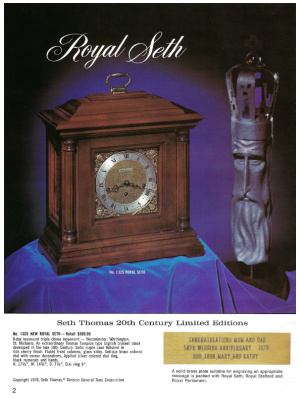 I decided to seek out the model of clock that was burned that day in 1982. It is the Seth Thomas "Royal Seth" mantel clock. The clock is quite large for a mantel clock and very heavy. It features a clock works mechanism with the designation A403-002. This was a Seth Thomas numbering system. The movement is actually the 1050-020 Hermle Clock Movement which uses a number 8 winding key. There are three different chimes that can be selected or no chimes.
I decided to seek out the model of clock that was burned that day in 1982. It is the Seth Thomas "Royal Seth" mantel clock. The clock is quite large for a mantel clock and very heavy. It features a clock works mechanism with the designation A403-002. This was a Seth Thomas numbering system. The movement is actually the 1050-020 Hermle Clock Movement which uses a number 8 winding key. There are three different chimes that can be selected or no chimes.I was really stoked to get the clock in great outward condition, but the mechanism had been abused. According to the Hermle website, reconditioning of these would be expensive, so they recommended purchase of a new 1050-020 movement - a direct replacement - for the low price of $405.00 - not including shipping. Gulp. That's more that I paid for the clock itself.
You can also find the A403-002 or 1050-020 Hermle movement on ebay - in various states of repair, for moderately high cost. However, I was fortunate to find a Seth Thomas Legacy V mantel clock (a significantly smaller clock) that also uses the A403-002, with the movement in great condition at a cost of only 60 dollars. I only had to adjust the hammers a little to get it working great. The chime is soft and pleasant, and I run it on the Westminster chime continuously. You can see more of this clock in action by viewing the YouTube video. This video has a shorter version of what has been covered in this article with the Royal Seth clock appearing in person towards the end of the video.
I'm not exactly sure what the clock means to me. It's a clock from a little known, very sad moment in Seth Thomas history. It represents how the day to day workers often get negatively affected in big business dealings. And it spurred me on to clarify some of the history of The Seth Thomas clock company.
As mentioned before, I have included links to newspaper articles in the description that highlights the major historical corrections that I claim. This research would not have been possible without my membership with Newspapers.com.
I'm hoping you might consider helping me correct the errors online when the chance arises. Here are six facts that I believe needs to corrected or reported in many online sources of the Seth Thomas History:
1) General Time Instruments Corporation (eventually known as General Time Corporation) was a holding company formed to merge The Seth Thomas Clock Company and the Western Clock Company of Illinois - the merger was approved by stockholders of both companies on November 12, 1930.
(General Time did not buy Seth Thomas).
2) General Time Corporation was merged with Talley Industries in 1970 in a hostile takeover orchestrated by the company's founder, Franz Talley.
(Talley Industries did not buy General Time in 1968).
3) Sunday, April 10, 1983 a new, "Royal Seth" Seth Thomas Mantel clock was burn in public during a mock funeral by workers protesting the factory closing in Thomaston, Connecticut.
4) April 15, 1983 - Seth Thomas Clockworks Factory in Thomaston formally closed after the last 4 workers were laid off.
5) In 1988 Fred Pistilli and four colleagues implemented a management buyout from Talley Industries due to Tally needing to divest itself of some companies to return to profitability. Fred Pistilli became president, CEO, and principal owner of General Time in 1988.
(A little reported fact).
6) In June 2001 General Time ceased operations, effectively ended the history of The Seth Thomas Clock company, 188 years after it's birth.
(The Seth Thomas Clock Company - 1813 to 2001)
7) The Colibri Group (also doing business under the name CST Enterprises) holds the rights to the Seth Thomas name and licenses the manufacture of a few clocks with the Seth Thomas name.
(These are not "real" Seth Thomas clocks - but at least the name lives on).
I hope you appreciate the research done here to set the record straight. It's something that I've wanted to do for years.
And now, going forward, if you visit Flip Clock Fans Studios, you will hear chimes from a Seth Thomas mantel clock in commemoration of The Seth Thomas Company - one of the greatest clock companies in US History.
YouTube Video
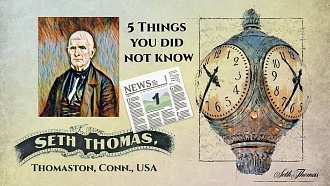
Check out the forum post to comment.
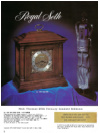
(very large version)
References:
1) Clock Burning Symbolizes Loss of Seth Thomas
Hartford Courant Mon Apr 11 1983 pages 17 and 20.
(part 1):
https://www.newspapers.com/clip/1066...ss-of-seth-th/
(part 2):
https://www.newspapers.com/clip/1066...ss-of-seth-th/
2a) Advice from Hartford, Conn
Fort Worth Star Telegram Sun Nov 2 1930 page 29
https://www.newspapers.com/clip/1066...merger-of-set/
2b) To Merge Clock Companies
The Kansas City Star Thu Oct 30 1930 page 21
https://www.newspapers.com/clip/1066...ock-companies/
2c) Clock Companies to Join in New Holding Company
The Herald Press Thu Oct 30 1930 page 2
https://www.newspapers.com/clip/1067...new-holding-c/
2d) Westclox Merges With Seth Thomas
Bureau County Tribune Fri Nov 7 1930 page 7
https://www.newspapers.com/clip/1067...h-seth-thomas/
3) Talley Takeover of General Time is Still Pending
The Cincinnati Enquirer Mon Jul 22 1968 page 47
https://www.newspapers.com/clip/1067...time-is-still/
4) Take Over Attempted - Fight Up in Air for Clock Firm
The Morning Call Sun Jul 21 1968 page 54
https://www.newspapers.com/clip/1067...-up-in-air-fo/
5) Talley Seeks to Bring About Merger With General Time
The Arizona Republic Tue Apr 2 1968 page 55
https://www.newspapers.com/clip/1067...t-merger-with/
https://www.newspapers.com/clip/1068...-stockholders/
7) Talley Proposes Formal Merger
The Pittsburgh Press Thu Feb 13 1969 page 26
https://www.newspapers.com/clip/1068...formal-merger/
7b) Time-Talley Link OK'd, Criticized
Press and Sun Bulletin Wed May 21 1969 page 9
https://www.newspapers.com/clip/1068...kd-criticized/
8) SEC okays merger of Talley, GT
The Arizona Republic Sat Jan 10 1970 page 36
https://www.newspapers.com/clip/1068...-of-talley-gt/
9) SEC Sues on Talley General Time Bid
Arizona Republic Sun Jul 21 1968 page 119
https://www.newspapers.com/clip/1068...eral-time-bid/
10) Talley Settles $75 Million in Lawsuits
The Los Angeles Times Tue Apr 16 1974 page 54
https://www.newspapers.com/clip/1068...n-in-lawsuits/
11) Industrialist Franz Talley Is Dead at 59
The Arizona Republic Tue Jun 20 1978 page 1
Part 1 -
https://www.newspapers.com/clip/1068...is-dead-at-59/
Part 2 -
https://www.newspapers.com/clip/1068...talley-dead-a/
12) Historic Clock Maker Decides It's Time To Move
Hartford Courant Wed Apr 28 1982 page 1 and A8
Part 1 -
https://www.newspapers.com/clip/1068...es-its-time-t/
Part 2 -
https://www.newspapers.com/clip/1068...ve-to-georgia/
13) Seth Thomas Owner Rejects State Offer
Hartford Courant Thu May 20 1982 page 1 and A19
Part 1 -
https://www.newspapers.com/clip/1068...s-state-offer/
Part 2 -
https://www.newspapers.com/clip/1068...rejects-state/
14) Talley loses $22.5 million in third quarter
The Arizona Republic Thu Nov 12 1987 page F6.
https://www.newspapers.com/clip/1068...in-third-quar/
15) Talley Industries plans major restructuring
Honolulu Star Bulletin Wed Oct 7 1987 page 57
https://www.newspapers.com/clip/1068...or-restructur/
15b) Talley Industries sets restructuring
The New York Times Oct 8 1987 page D4
https://timesmachine.nytimes.com/tim...08/317987.html
16) General Time shuts down
The Naples Daily News Thu Jun 7 2001 page 49
https://www.newspapers.com/clip/1068...me-shuts-down/
Check out the forum post to comment.

